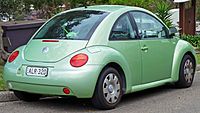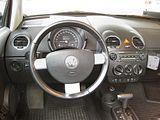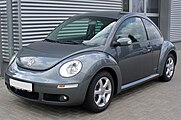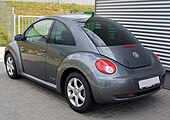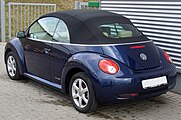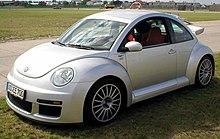VW New Beetle
| Volkswagen | |
|---|---|
|
VW New Beetle (1997-2005)
|
|
| New Beetle (type 9C) | |
| Production period: | 10 / 1997-07 / 2010 |
| Class : | Compact class |
| Body versions : | Station wagon , convertible |
| Engines: |
Otto engines : 1.4–3.2 liters (55–165 kW) Diesel engines : 1.9 liters (66–77 kW) |
| Length: | 4129-4148 mm |
| Width: | 1721 mm |
| Height: | 1498 mm |
| Wheelbase : | 2515 mm |
| Empty weight : | 1182-1292 kg |
| successor | VW Beetle |
| Stars in the Euro NCAP - Crash Test |
|
The New Beetle ( Type 9C ) is an automobile of the Volkswagen brand , whose retro design is based on the VW Beetle and which was produced from October 1997 to July 2010.
In autumn 2011 it was replaced by the VW Beetle .
From "Concept 1" to "New Beetle"
The Concept 1

In 1992 Volkswagen began work on a concept for a vehicle based on alternative drive systems at the American Design Center founded in 1991 in Simi Valley , California . The aim was to be completely emission-free. Extensive market research in the USA found that the Beetle was most associated with the Volkswagen brand among the population in North America .
The designers Freeman Thomas and J Mays created the design study "VW Concept 1" as a modern interpretation of the VW Beetle. In 1994 the Concept 1 was first presented to the public at the Detroit Motor Show . The response from the public and the trade press was surprisingly enthusiastic.
In 1995, the "VW Concept 1" convertible was presented at the Geneva Motor Show , which increased public interest in the vehicle. The reactions to the new model were so positive that Volkswagen complied with the demands of the public and developed the study further. In Geneva , Volkswagen spoke for the first time about possible series production. The floor pan for the future Polo generation was originally planned . In 1995, in addition to a 1.9-liter turbo diesel (66 kW) with a 5-speed Ecomatic transmission, a 1.4-liter three-cylinder turbodiesel (50 kW) with an 18 kW electric motor ( hybrid ) and a 37 kW electric induction motor from Siemens with two-stage automatic.
In 1995, a second revised prototype was presented in Japan and it was officially announced that the vehicle would go into series production . Basis for the series version which should A4 - platform of the Golf IV be.
New Beetle
On January 5, 1998, the New Beetle was officially presented at the Detroit Motor Show. This made Volkswagen one of the first manufacturers to bring a vehicle with a so-called retro design onto the market.
The design of the "New Beetle", with the free-standing fenders , the round shape of the front hood and the indicated running boards , is an allusion to the VW Beetle . Much of the interior design is also reminiscent of the Beetle, such as the handle over the glove compartment, the straps on the B-pillar , the round instrument cluster , the luggage nets on the doors and the famous flower vase on the dashboard. Like the Golf IV , Audi A3 and Škoda Octavia , the chassis of the New Beetle is based on the A4 platform. Due to the group platform, the implementation of a rear engine had no chance. The only new parts that were installed on the existing A4 platform were the radiator and fan, the three-spoke steering wheel and a modified tank filler neck. The vehicle springs and the exhaust system also had to be adapted. Compared to the Concept 1, the New Beetle has pronounced bumpers, the indicators moved from the headlights into the bumpers, the opening for the tailpipe of the exhaust system in the rear apron was omitted, the round exterior mirrors were replaced by elongated ones and the horn grilles were omitted. The abandonment of the rear engine so typical of the VW Beetle in favor of a front engine was criticized by some customers.
The Volkswagen New Beetle was manufactured in Puebla , Mexico . In spring 2003 the New Beetle Cabriolet (factory ID: Type 1Y) was presented. The convertible also shows many parallels to the VW Beetle Cabriolet, for example the open top that rests on the body and is protected from dirt by a tarpaulin .
Facelift
At the IAA 2005 , the modified New Beetle was presented to the public as a sedan and convertible. New additions included the flatter fenders and reshaped bumpers, while the clear-glass headlights were now oval. Other visual features were the narrower front indicators and the more conspicuous two-tone tail lights.
As part of the facelift, the small side indicators had already moved into the exterior mirror housings, the VW emblems were changed from blue-white-chrome to gray-chrome, the rotating rear emblem was exchanged for a static one, and the door lock on the passenger side was removed and the lock / Unlocking is now generally equipped with radio central locking. The Golf IV technology was retained until the model change in 2010, although the Golf IV had already been replaced in 2003 by a successor model (Golf V) with a new platform.
Vehicle identification
With the help of the vehicle identification number, which is located under the back seat as in the earlier Beetle models, you can roughly determine the destination of the New Beetle; the following vehicle classes can be distinguished:
- Type 1C: New Beetle - USA, Mexico, North America Region (NAR)
- Type 9C: New Beetle - Europe and Rest of the World (RDW)
- Type 1Y: New Beetle Cabrio - USA, Mexico, Europe, North America Region (NAR) and Rest of the World (RDW)
Technical specifications
| element | Data |
|---|---|
| Track width (front / rear) | 1508 mm / 1494 mm |
| Turning circle | 10.9 m |
| transmission | 5-speed manual transmission (02J) 4-speed automatic transmission (01M) |
| Braking system | Front disc brakes (internally ventilated) 280 mm × 22 mm Rear disc brakes |
| Trunk volume (min./max.) | 209 l / 527 l |
| c w value | 0.38 ( beetles : 0.48) |
| Fuel consumption | 7.1 liters / 100 km |
"New Beetle Cup" racing car
In 1999, VW Motorsport converted a total of 40 New Beetle vehicles for Volkswagen's planned “New Beetle Cup”. An original New Beetle body shell served as the basis, which was reinforced by the Heggemann company and retrofitted with a safety cell. A 2.8-liter VR6 -24V motor with a modified map was used as the drive. The engine developed 204 hp with 270 Nm torque. The dimensions of the cup vehicles are (L × W × H) 4081 mm × 1804 mm × 1450 mm.
- Transmission: 6-speed sports transmission, straight teeth, front-wheel drive
- Coupling: serial coupling
- Chassis: Bilstein H&R sports chassis, height adjustable, Uniball on the front axle
- Brake system: ATE racing ABS front: 4-piston fixed caliper Alcon, internally ventilated multi-part ATE Power Disc rear: standard floating caliper, Pagid racing brake pads, non-ventilated ATE Power Disc
- Wheels: OZ / 9 × 18 ET 11
- Tires: 235 / 625-18 ( slick + rain)
- Safety devices: airbag, safety cell, full bucket seat, fire extinguishing system, 6-point seat belt, window net, racing ABS, side impact protection, safety tank bladder inside the original fuel tank
- Instrumentation: Motorsport instrument cluster (Magneti Marelli), data recording
- Pneumatic lifting system with four air pressure cylinders and non-return valve behind the passenger door
Changes from 2002: Measurement technology for precise engine data such as speed, temperatures and various pressures was introduced. The technology can also read out driving data such as speed, G values and brake pressure. The improved cooling and the new engine control unit are also expected to provide increased performance.
One of the most famous pilots was Smudo .
New Beetle "RSi" special model
In 2001, Volkswagen brought the most powerful production version of the New Beetle, the "RSi" ( R enn S port i njection) on the market. The engine used is based on a 2.8-l VR6 engine with four-valve technology, the displacement of which has been increased to 3.2 l and has an output of 165 kW (224 hp). The model was limited to 250 units and was optically based on the VW New Beetle Cup.
The dimensions of the New Beetle RSi differ slightly from those of the New Beetle. The body is 86 mm wider, 19 mm longer and the track widths have been increased by 45 mm at the front and 59 mm at the rear.
The RSi-specific equipment is:
- Dash panel insert with two large round instruments. The left instrument contains the rev counter, the displays for fuel level and coolant temperature and a digital clock. The right instrument contains the speedometer and the odometer with service interval display. The switching point display is located in the top center to show certain important speed ranges.
- At the point where an audio system is installed in the normal New Beetle, there are additional instruments for the oil pressure, the oil temperature and a voltmeter in the center console.
- Button for starting the VR6 engine in the center console next to the handbrake lever.
- CD audio system in the headliner with separate arrangement of operating unit and control unit.
- Heated rear window with large window antenna.
| element | Data |
|---|---|
| Length Width Height | 4148 mm / 1810 mm / 1475 mm |
| wheelbase | 2515 mm |
| Track width (front / rear) | 1553 mm / 1553 mm |
| Turning circle | 10.9 m |
| Tank volume | 63 l |
| transmission | 6-speed manual transmission (02M) 4-MOTION all-wheel drive with Haldex clutches |
| Brake system (front / rear) | Front disc brakes (internally ventilated) 312 mm × 25 mm Rear disc brakes (internally ventilated) |
| Wheel and tire combinations | 235 / 40ZR18 - 9J × 18ET10 (this dimension is not intended for snow chains)
205 / 55R16 - 7J × 16ET10 (this dimension is intended for snow chains) |
| acceleration | 0 to 100 km / h in 6.4 seconds |
| Weight (empty) | 1515 kg |
| c w value | 0.38 ( beetles : 0.48) |
New Beetle "Sport Edition" special model
The "Sport Edition" was available from the year of construction 2001 with a 1.8-l turbo engine and 110 kW (150 PS) as well as a 2.3-l VR5 engine with four-valve technology and 125 kW (170 PS). The automatically extending rear spoiler (from 150 km / h), which is only available with these two engines, is also standard in the Sport Edition.
The "New Beetle Sport Edition" special model was available in the following paintwork:
- Black (A1)
- Reflex silver metallic (8E)
Additional interior fittings
- Sports leather seats with two-tone cover and colored stitching (black / crystal gray)
- White instrument lighting
- Clear flower vase with aluminum ring
- Brake, clutch and accelerator pedals with attached aluminum plate
- Floor mats in black with a gray border
- Handbrake lever handle in black leather with colored stitching
- Height-adjustable front seats
- Leather steering wheel with aluminum decor
- Gear lever gaiter in black leather with colored stitching
- Door and side panels in partial leather, color-coordinated with the trim color
- Leather gear knob with aluminum ring
- Chrome bonnet and trunk lift
- Aluminum door pins
Additional exterior equipment
- Exhaust system with double tailpipe
- "Delta X" 17 ″ × 7.5J alloy wheels with 225 mm tires
- Front bumper with new indicators, yellow side marker lights (SML), new grille and integrated fog lights
- Rear bumper with diffuser and red side marker lights (SML)
Additional functional and safety equipment
- Storage pockets on the back of the front seats
- "Easy Entry" entry aid
- Lumbar support for front seats
- Heatable front seats
- Side airbag on the driver and passenger side
- Brake system of the New Beetle "RSi" (not on the 1.8T)
- Gas-filled shock absorber
New Beetle "Dark Flint" special model
At the beginning of 2005 the first convertible special model "Dark Flint" appears. This special model is particularly noticeable because of its high-contrast and extensive equipment. This special model was presented in the exterior color anthracite with a pomegranate-red hydraulic convertible top in combination with a burgundy-red leather interior. The 17 ″ “Take Five” alloy wheel with red inserts was used to match the burgundy red interior. The "Dark Flint" model was limited to 250 vehicles.
The New Beetle convertible "Dark Flint" was available with three engines (two petrol and one diesel):
- 1.6 l 75 kW (102 PS), 5-speed gearbox
- 2.0 l 85 kW (115 PS), 5-speed gearbox or 6-speed automatic
- 1.9 l TDI 74 kW (100 PS), 5-speed gearbox
Additional interior fittings
- Comfort perforated leather seats with burgundy cover and burgundy stitching
- Gear knob, center armrest, handbrake lever and handle in burgundy leather
- Textile floor mats in black with burgundy knurling
- black leather steering wheel with burgundy stitching
- Gear lever sleeve in burgundy leather with colored stitching
- Door and side panels in synthetic leather and seams in burgundy red, color-coordinated with the trim color
- Wind deflector
Additional exterior equipment
- “Take Five” alloy wheels 17 ″ × 7J with 225 mm tires and colored inserts
- electric, hydraulic soft top in pomegranate red
- Tarpaulin in black
Additional functional and safety equipment
- Electric windows front and rear
- manual air conditioning
- Park pilot
- “Gamma” radio system with CD player and ten loudspeakers
- Central locking with radio remote control
- Winter package: fog lights, heated front seats, heated windscreen washer nozzle
- "Easy Entry" entry aid
Engine range
When it was launched in March 1998, the New Beetle was initially offered with two Golf IV engines. In addition to the 1.9 l diesel engine with 66 kW (90 hp) and the gasoline engine with 2.0 l displacement and 85 kW (116 hp), a 1.8 liter turbo engine with 110 kW (150 hp) introduced.
| model | Cylinders / valves |
Cubic capacity cm³ |
Max. Power kW (hp) at min -1 |
Max. Torque Nm at min -1 |
Motor ISIN letters |
construction time space |
variant |
|---|---|---|---|---|---|---|---|
| Inline four-cylinder | |||||||
| 1.4 | 16 | 1390 | 55 (75) / 5000 | 126/3800 | BCA | 10.2001-07.2010 | Hatchback, cabriolet |
| 1.6 | 8th | 1595 | 74 (101) / 5600 | 145/3800 | AWH | 11.1999-10.2000 | Hatchback |
| 1.6 | 8th | 1595 | 75 (102) / 5600 | 148/3800 | AYD / BFS | 06.2000-07.2010 | Hatchback, cabriolet |
| 1.8 T | 20th | 1781 | 110 (150) / 5700 | 210 / 1750-4600 | AGU | 01.1998-06.2000 | Hatchback, cabriolet |
| 1.8T | 20th | 1781 | 110 (150) / 5800 | 220 / 2000-4200 | APH / AVC / AWC / AWU / AWV / BKF |
01.1999-07.2010 | Hatchback, cabriolet |
| 1.8T | 20th | 1781 | 132 (180) / 5500 | 235 / 1950-5000 | AWP | 06.2002-06.2004 | Hatchback |
| 2.0 | 8th | 1984 | 85 (116) / 5400 | 165/2800 | AEG | 01.1998-10.2001 | Hatchback |
| 2.0 | 8th | 1984 | 85 (116) / 5200 | 170/2400 | APK / AQY | 03.1998-09.2001 | Hatchback |
| 2.0 | 8th | 1984 | 85 (116) / 5200 | 172/3200 | AZJ / BDC / BEJ / BER / BEV / BGD / BHP |
11.2001-07.2010 | Hatchback, cabriolet |
| Five-cylinder | |||||||
| 2.3 V5 | VR5 / 20 | 2324 | 125 (170) / 6200 | 220/3300 | AQN | 10.2000-05.2005 | Hatchback |
| 2.5 | R5 / 20 | 2480 | 110 (150) / 5000 | 228/3750 | BPR / BPS | 2006-2010 | Hatchback |
| Six-cylinder - VR engine | |||||||
| 3.2 (RSI) | 24 | 3189 | 165 (224) / 6200 | 320/3000 | AXJ | 10.2000-03.2003 | Hatchback |
| model | Cylinders / valves |
Cubic capacity cm³ |
Max. Power kW (hp) at min -1 |
Max. Torque Nm at min -1 |
Motor ISIN letters |
construction time space |
variant |
|---|---|---|---|---|---|---|---|
| 1.9 TDI (VEP) | R4 / 8 | 1896 | 66 (90) / 4000 | 210/1900 | ALH | 01.1998-06.2004 | Hatchback |
| 1.9 TDI (PD) | R4 / 8 | 1896 | 74 (101) / 4000 | 240 / 1800-2400 | ATD / AXR / BEW | 10.2000-05.2005 | Hatchback, cabriolet |
| 1.9 TDI (PD) | R4 / 8 | 1896 | 77 (105) / 4000 | 240 / 1800-2200 | BSW | 05.2005-07.2010 | Hatchback, cabriolet |
Technical specifications
The following engine variants were available (details in brackets refer to the US version of the New Beetle):
| VW New Beetle | 1.4 (2001-2010) |
1.6 (1999-2000) |
1.6 (2000-2010) |
1.8T (1999-2010) |
2.0 (1998-2001) |
2.0 (2001-2010) |
2.3 V5 (2000-2005) |
3.2 RSI (2000-2003) |
1.9 TDI (1997-2004) |
1.9 TDI (2000-2005) |
1.9 TDI (2005-2010) |
|---|---|---|---|---|---|---|---|---|---|---|---|
| Engine: | 4-cylinder in-line engine (four-stroke) | 5-cylinder VR engine (four-stroke) | 6-cylinder VR engine (four-stroke) | 4-cylinder in-line engine (four-stroke) | |||||||
| Displacement: | 1390 cm³ | 1595 cc | 1781 cc | 1984 cc | 2324 cc | 3189 cm³ | 1896 cc | ||||
| Bore × stroke: | 76.5 mm × 75.6 mm | 81 mm x 77.4 mm | 81 mm x 86.4 mm | 82.5 mm × 92.8 mm | 81 mm x 90.2 mm | 84 mm x 95.9 mm | 79.5 mm × 95.5 mm | ||||
| Performance at 1 / min: | 55 kW (75 PS) at 5000 |
74 kW (101 hp) at 5600 |
75 kW (102 PS) at 5600 |
110 kW (150 PS) at 5800 |
85 kW (116 hp) at 5200 |
125 kW (170 hp) at 6200 |
165 kW (224 hp) at 6200 |
66 kW (90 PS) at 4000 |
74 kW (101 hp) at 4000 |
77 kW (105 PS) at 4000 |
|
| Max. Torque at 1 / min: | 126 Nm at 3300 | 145 Nm at 3800 | 148 Nm at 3800 | 220 Nm at 2000-4200 | 170 Nm at 2400 | 172 Nm at 3200 | 220 Nm at 3300 | 320 Nm at 3000 | 210 Nm at 1900 | 240 Nm at 1800–2400 | 240 Nm at 1800–2200 |
| Compression: | 10.5: 1 | 10.3: 1 | 10.5: 1 | 9.5: 1 | 10.5: 1 | 10.3: 1 | 10.8: 1 | 10.8: 1 | 19.5: 1 | 19.0: 1 | 19.0: 1 |
| Mixture preparation: | Multi-point manifold injection | Multi-point intake manifold injection + turbocharger and intercooler | Multi-point manifold injection | Direct injection with VEP + turbocharger and intercooler | Pump-nozzle system + turbocharger and intercooler | ||||||
| Valve control: | DOHC , timing belt | OHC , timing belt | DOHC, timing belt | OHC, timing belt | DOHC, chain | OHC, timing belt | |||||
| Cooling: | Water cooling | ||||||||||
| Transmission: | 5-speed gearbox (RSI: 6-speed gearbox) 1.6 102, 1.8T, 2.0 and 1.9 TDI 90 aW 4-speed automatic front-wheel drive (RSI: all-wheel drive) |
||||||||||
| Front suspension: | Suspension struts, wishbones, coil springs | ||||||||||
| Rear suspension: | Twist beam axle, coil springs | ||||||||||
| Brakes: | Disc brakes front and rear, brake booster, ABS, aw ESP | ||||||||||
| Steering: | Rack and pinion steering, servo | ||||||||||
| Body: | Sheet steel, self-supporting | ||||||||||
| Track width front / rear: | 1505/1485 mm | ||||||||||
| Wheelbase: | 2515 mm | ||||||||||
| Dimensions: | 413 cm × 172 cm × 150 cm | ||||||||||
| Empty weight (sedan): | 1180 kg | 1210 kg | 1200 (Aut. 1240) kg | 1220 (Aut. 1290) kg | 1230 (Aut. 1255) kg | 1245 (Aut. 1255) kg | 1325 kg | 1515 kg | 1250 (Aut. 1275) kg | 1290 kg | 1290 kg |
| Empty weight (Cabriolet): | 1275 kg | - | 1300 kg | 1390 (Aut. 1410) kg | - | 1335 (Aut. 1345) kg | - | - | - | - | 1350 kg |
| Top speed (sedan): | 161 km / h | 178 km / h | 179 (Aut. 175) km / h | 203 (Aut. 199) km / h | 185 (Aut. 182) km / h | 185 (Aut. 182) km / h | 211 km / h | 225 km / h | 171 (Aut. 168) km / h | 178 km / h | 180 km / h |
| Top speed (Cabriolet): | 160 km / h | - | 178 km / h | 202 km / h | - | 184 (Aut. 181) km / h | - | - | - | - | 179 km / h |
| 0-100 km / h (sedan): | 14.6 s | 11.7 s | 11.6 (Aut. 13.2) s | 8.7 (Aut. 9.5) s | 10.9 (Aut. 12.9) s | 10.9 (Aut. 12.9) s | 8.7 s | 6.7 s | 13.1 (Aut. 14.4) s | 12.4 s | 11.5 s |
| 0-100 km / h (Cabriolet): | 15.6 s | - | 12.3 s | 9.3 s | - | 11.7 (Aut. 12.9) s | - | - | - | - | 12.0 s |
Individual evidence
- ^ Crash test VW New Beetle
- ↑ https://www.hdg.de/lemo/jahreschronik/1998.html
- ↑ Thomas Geiger, Marco Dalan: Retro-Design: Why new cars like to look old so much. In: welt.de . September 21, 2007, accessed October 7, 2018 .
- ↑ Technical data ( Memento from April 15, 2008 in the Internet Archive )
- ↑ On the occasion of the Beetle Sunshine Tour to Wolfsburg 2018: volkswagen-newsroom.com, accessed on September 7, 2018.
literature
- Keith Seume: The Beetle - The Comprehensive Illustrated Story of the World's Most Popular Car. Karl Müller Verlag, Erlangen 1998, ISBN 3-86070-491-5 , original from CLB International, Dodalming, Surrey, England.
- Ivan McCutcheon: The New Cult - VW Beetle. Neff, Rastatt 1999, ISBN 3-8118-5406-2 .
- Folker Kraus-Weysser: New Beetle. Steiger Verlag, Augsburg 1999, ISBN 3-89652-184-5 .
- Walter drafter: VW Käfer and New Beetle since 1938. Schrader Verlag, Stuttgart 1999, ISBN 3-613-87189-0 .
- Jens Kron: The Beetle - a legend returns. Mixing, Neckarsulm 1999.
- Jürgen Lewandowski, Herbert Völker, Marion Zellner: New Beetle. Delius Klasing Verlag, Bielefeld 1998, ISBN 3-7688-1085-2 .
- Volkswagen AG - Sales Customer Service (Ed.): Your New Beetle. 1st edition, Wolfsburg 1998, Art. No. 016.5001.12.00.
- Hartmut Schrader: Typenkompaß - VW passenger cars since 1945. 1st edition, Motorbuch Verlag, Stuttgart 1998, ISBN 3-613-01905-1 .
- Bob Henderson, John H. Haynes: VW New Beetle - Automotive Repair Manual. Haynes Publishing Group, Somerset 2000, ISBN 1-56392-362-9 .

